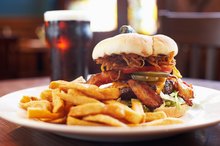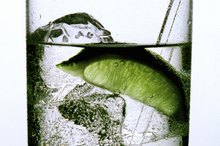Esophagus Symptoms of Alcoholism
Cirrhosis of the liver was the twelfth leading cause of death in the United States in 2005 and developed as a consequence of alcoholism in over 45 percent of cases, the National Institute on Alcohol Abuse and Alcoholism reports 4. Alcoholics often develop problems with the esophagus, which is the tube that leads from the mouth to the stomach, as a consequence of cirrhosis or in addition to the disease. Alcohol damages the cells lining the esophagus and can cause life threatening complications.
If you are experiencing serious medical symptoms, seek emergency treatment immediately.
Gastrointestinal Esophageal Reflux
Because even one drinking episode weakens the lower esophageal sphincter, according to Montana State University, gastrointestinal reflux disease, often called GERD, often affects alcoholics 3. Incompetence of the sphincter allows stomach acid to back up into the esophagus, burning and irritating the tissues. Untreated reflux eventually causes the cells of the esophagus to look more like stomach or intestinal cells than esophageal cells, a condition called Barrett’s esophagus, the University of Pennsylvania explains 3. These cells can secrete acid directly into the esophagus. Barrett’s esophagus increases the risk of developing cancer of the esophagus, even if medical or surgical treatments are done. Frequent medical checkups and testing to detect abnormal cells early may help prevent cancer.
- Because even one drinking episode weakens the lower esophageal sphincter, according to Montana State University, gastrointestinal reflux disease, often called GERD, often affects alcoholics 3.
- Barrett’s esophagus increases the risk of developing cancer of the esophagus, even if medical or surgical treatments are done.
Esophageal Varices
Bile Acid in the Stomach
Learn More
In alcoholics, esophageal varices develop when scarring in the liver, called cirrhosis, slows the flow of blood into the liver 1. Blood backs up into the portal vein that leads into the liver and into the smaller veins leading into it. The enlarged blood vessels rupture, causing bleeding, in around one-third of people with varices, MayoClinic.com reports 1. Vomiting of blood, black, tarry stools, lightheadness, fainting, low blood pressure, a decrease in urine output and shock an occur. Surgical banding of the varices closes off the dilated blood vessels.
Esophageal Strictures
Esophageal strictures occur when damage to the cells lining the esophagus causes scarring and narrowing of the opening over time. Strictures may become cancerous, especially in smokers and alcoholics, the University of Pennsylvania warns 3. Esophageal strictures make it difficult to swallow. Dilating the stricture relieves symptoms.
- Esophageal strictures occur when damage to the cells lining the esophagus causes scarring and narrowing of the opening over time.
- Strictures may become cancerous, especially in smokers and alcoholics, the University of Pennsylvania warns 3.
Esophageal Cancer
The Effects of Long-Term Usage of Prilosec
Learn More
There are two types of esophageal cancer, both of which are associated with alcohol abuse 2. Squamous cell cancer is related to smoking and alcohol, while adenocarcinoma is much more common in people with Barrett’s esophagus, which complicates GERD, according to MedlinePlus 2. Heartburn, chest pain, vomiting and difficulty swallowing are warning signs of esophageal cancer, which is surgically removed if the cancer hasn’t spread beyond the esophagus 2.
Related Articles
References
- MayoClinic.com: Esophageal Varices
- MedlinePlus: Esophageal Cancer
- University of Pennsylvania: Gastro-Esophageal Reflux Disease
- National Instute on Alcohol Abuse and Alcoholism: Liver Cirrhosis Mortality in the United States
- American Cancer Society. What Is Cancer of the Esophagus?
- American Cancer Society. Signs and Symptoms of Esophageal Cancer
- American Cancer Society. Esophageal Cancer Risk Factors
- American Cancer Society. Tests for Esophageal Cancer
- American Cancer Society. Surgery for Esophageal Cancer
- American Cancer Society. Immunotherapy for Esophageal Cancer
- CancerCare. Coping With Esophageal Cancer
- American Society of Clinical Oncology. Esophageal Cancer: Signs and Symptoms. Updated 12/2016.
- Bast, R., Croce, C., Hait, W. et al. Holland-Frei Cancer Medicine. Wiley Blackwell, 2017.
- National Cancer Institute. Esophageal Cancer Treatment (PDQ)—Health Professional Version. Updated 02/06/18.
Writer Bio
A registered nurse with more than 25 years of experience in oncology, labor/delivery, neonatal intensive care, infertility and ophthalmology, Sharon Perkins has also coauthored and edited numerous health books for the Wiley "Dummies" series. Perkins also has extensive experience working in home health with medically fragile pediatric patients.









